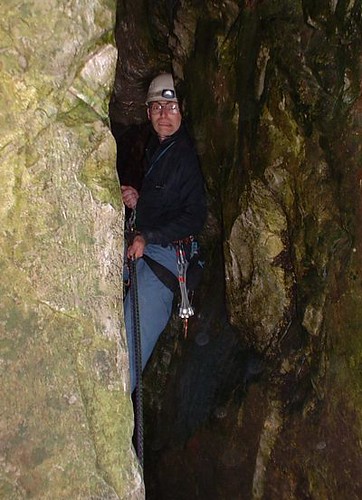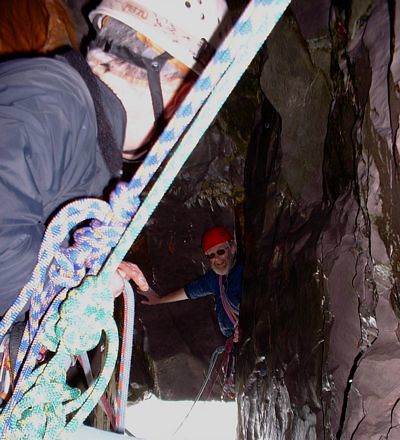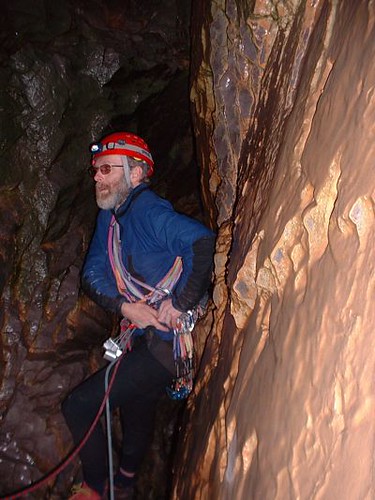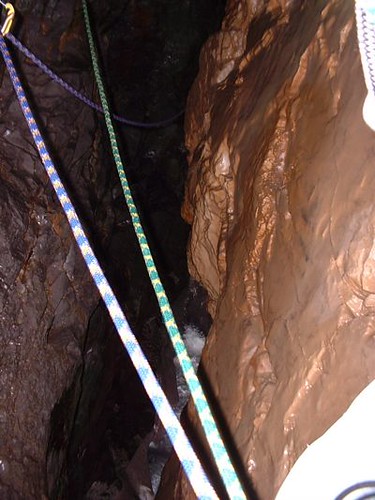By Guy Reid, Simon Chandler & Martin Hore – June 2005
The weather in Pembroke over this year’s May Day Bank Holiday weekend meant that
the IMC had a slightly later than usual start each day as we waited for the
overnight inclemency to be burnt back by the hoped-for sun before making any
rash decisions. However despite all precautions, and with some previous
knowledge, a rash decision was still made. Martin Hore has long felt that the
current guidebook does not paint an adequate picture of the route so within
hours of returning from our jaunt he wrote a new description (see below) that he
will be submitting; what follows that are two slightly more personal
reminiscences of . . .
Preposterous Tales, 190 feet, E2 *** (by Martin Hore)
This route enters the western-most of the two sea caves to emerge from a
prominent hole 40 feet back from the cliff edge: an unique and memorable
expedition not to be underestimated. Many parties have epics. Pitch 1 (the
daylight section) is E1 5b. The remainder may be ungradeable; E2 is proposed to
deter the unprepared. Experience of caving or mountain routes in bad conditions
may be an asset.
A fall by either leader or second from the crux on pitch 1, or from any part of
pitch 2 is likely to leave the climber hanging in space. Come prepared to
prussic! Though the route can be climbed by natural light, head-torches are
advisable for gear placement and possible benightment. The route should not be
attempted in rough seas. Start as for Quoin.
1. 80 feet 5b. Traverse horizontally right (facing in). Avoid a blank section by a short
descent then climb back up to a prominent flat handhold on the arete. Cross a
short overhanging wall on jugs and enter the apex of the cave beneath a large
thread. Chimney onwards into the cave, and arrive at a stance where the gap
beneath ones feet temporarily closes.
2. 60 feet 4c (if dry, but expect it to be wet). Bridge onwards into the cave
descending slightly until the passage opens into a huge cavern. At the very
brink step precariously across to the right (East) wall and pull left above the
void to a small square ledge. Ascend steeply to a niche, face right and cross to
the West wall. Large holds lead right and slightly down to a narrow ledge above
nothing, from where a stiff pull up around a rib gains the bottom of the exit
shaft. Good stance and belays 15 feet higher. Careful ropework is essential to
protect the second on this pitch.
3. 50 feet 4c (if dry etc…). Climb the corner, on the right where it steepens,
and emerge, relieved, into the daylight.
More Preposterous tales
By Simon Chandler
Seven us were camping at St Petrox over the May Day bank holiday weekend
for the annual IMC climbing trip to Pembrokeshire. Saturday morning started
grey and damp from the previous night’s rain, but as always Guy and I were
keen to get to the cliffs. We’d shared the journey to Wales with Martin
Hore, and had agreed to climb in a group of three with him on this first
day. We made a hurried plan to meet the others at St Govan’s, and then hustled
Martin into Guy’s car. Just as we started to pull away I was struck with a
crazy idea – Martin’s done the route before, so lets get him to show us the
way through … drum roll please … Preposterous Tales!
Two years ago Mervyn had organized the May Day trip and had travelled to
Pembrokeshire several days early. A forecast of bad weather caused the rest
of the IMC to go to the Peak District, abandoning poor Mervyn. Fortunately he
managed to team up with the Cambridge Climbing and Caving Club (the 4C’s)
and joined them for a trip through Preposterous Tales. The tale of his
adventure, involving a fall from the overhanging first pitch and the
subsequent prussiking above a raging sea, was recounted in the June 2003 IMC
Newsletter. Somehow this story had inspired me, and I was about to find out
for myself what an amazingly unique and surreal experience this route could be.
Preposterous Tales starts on a ledge at sea level, traverses rightwards
above the undercut base of the cliff into a cave. It then winds maze-like
inwards before exiting through a blowhole at the top of the cliff about 30
ft back from the edge. Arriving at the cliff top the blowhole was easy to
find. From a vantage point some 40ft to the left of this it was even
possible to peer over the cliff top to see the starting ledge. So far so
good. At least we knew where to throw down the abseil rope. We geared up
and did rock-paper-scissors to decide who’d lead the first pitch – at 5b
the most technical of the three, and the scene of many prussiking
adventures. I ‘won’ so abseiled down first. I almost made the same mistake
as Mervyn two years previously and stopped at the first ledge I reached.
Just in time I realized this was too high, and scrambled down to the lower
ledge just above sea level. While setting up the first stance Guy and
Martin joined me on the ledge.
From the booming sound of the sea you could tell that around the corner to
my right was a large sea cave. A slow rising traverse, I was told, would
take me to the very apex of the hidden cave mouth, which I should enter then
set up a belay. Once around the corner we wouldn’t be able to hear each
other so we agreed on a code of tugs on the rope: one for take in, two for
slack, three for climb when ready. I also took Martin’s advice and kept the
abseil rope clipped to my harness – this would prevent a fall into the sea
if I fell at the crux. I set off on the traverse, aiming for a prominent
flat hold out on the arete, silhouetted against the sky.
At first the
traverse was easy, then I reached a blank section. I either had to go under
this, or over it. Unfortunately Martin couldn’t remember which was the
right way. I first tried going under the blank rock, but dropping lower
makes your legs go under the overhang so putting lots of weight on your
arms. I didn’t like that, so backed up and tried going over the blank
section. Nope. No gear. So it was back to plan A. A committing side-pull
move took me under the blank section, but the weight was still on my arms
and I was tiring fast. I reached the arete with its big flat hold. It was
certainly a jug, but my legs were still under the overhang so weren’t
supporting my weight. Starting to panic I managed get a nut into a vertical
crack to the right of the jug just as my arms gave out. I was dangling, but
at least I was right by the gear and didn’t have to prussik back up to the
rock.
I could now see the cave 12ft to my right. A sequence of moves on big
jugs – but with little help from the feet – would take me to an obvious
rest at the cave mouth. I started the sequence and was almost there – my
hand inches from a massive thread hole – when the abseil rope that was
still clipped to my harness went tight. It was holding me back, preventing me from getting any closer to the
rest. Again my strength was fading fast and I started to panic. Fortunately I managed
to place a solid large friend and clipped my harness straight into it. OK,
so this was aid climbing, but I needed help and in this position nobody
could see my antics. I hauled up on the friend, unclipped the abseil rope
and managed to throw a long tape loop through the thread hole. I clipped into this,
so any fear of swinging out below the overhand was
gone. Detaching myself from the friend I made a couple of moves before
jamming my head and shoulders into the cave mouth. At last the weight was
back on my feet. I turned on my headtorch. Now all I had to do was
back-and-foot my way across 15ft of wet rock above a void, with no
handholds or gear placements. Somehow this didn’t seem so bad – either because of my experience caving, or because I was so thankful to have survived the overhang.
Safe at last, I placed several belay anchors then
tugged three times on the rope …
‘IMC 2 – Preposterous Tales 1’ or ‘When is the next rope-work course?’
By Guy Reid
This is my kind of climb, I thought, as I started after Simon on the
first pitch; the day was now bright, the rock dry, and seconding I only had to
worry about ensuring Martin was protected when he followed me. I was in my
element, the sun above and the sea below, as I moved up to the long tape loop hanging from the thread hole.
Passing underneath and into the mouth of the cave I started to get a sense
that this was no ordinary climb as I performed a not-to-be-recommended ‘head
jam’, though at the time it was all that I felt was possible. Extricating myself
from that dilemma I was then presented with a route that had a vaguely
anatomical feel to it. Now I have never climbed up someone’s colon but dark,
wet, slimy and very slippery is what I would expect, and that is exactly what I
was confronted with …
 |
Simon says ‘Back and Foot’. I say ‘You can not be serious’.
Simon says ‘Put a foot there then your hand over there then your shoulder
then your back’. I say ‘You can not be serious’.
Simon says ‘Then shuffle along, that’s back and footing’. I say ‘You can not
be serious’.
He was serious, so I put my faith in his directions and set off. It worked a
treat and though I was bloomin’ glad to be on a rope the consequences of a slip,
just like on a traverse, did not look like fun.
Joining Simon on the belay was like taking my place in a spider’s web, and
after making myself safe I sat back and watched with admiration as Simon alerted
Martin and began taking in, as the latter began his climb to join us.
 |
I think Martin ‘enjoyed’ the same qualms as I had as he made the final moves
to join us on the belay and then he was racking up ready to set off on Pitch 2.
 |
Simon followed on from Martin and then it was my turn.
 |
I had heard Martin and Simon discussing the way across what had looked like,
from the belay stance, a relatively innocuous small step, but I was soon to
discover the reality.
After a few failed attempts I called up to Martin for some advice.
‘Have you found some nice undercuts?’
‘Yes,’ I reply, pleased with myself.
‘You’ve gone too high.’
Back down, back across and I have to start again. And again. And again. And
again. And aaaagggghhhhh.
And all of a sudden I’m swinging in mid-air in the middle of a huge cave;
thundering sea way below my feet, the rope above me and the sloping ledge I was
trying to get to just at the tip of my outstretched fingers.
‘Don’t panic Mr Mainwairing, don’t panic.’
Martin and Simon were out of sight and communication was very difficult. In
such a situation it is imperative to shout loudly and clearly; concise
information, each word separate.
‘MartinSimoncanyouhearmeI’
mdanglingbtucanseewhereIneedtobegivemeslackIthinkIcanrestonaprojectingfinandmove
fromthereoopsnothatisn’tworkingtakeinImaytrytoprussicoopsaaaghslippedgosh.’
I always carry prussic loops and have read the books; but it was dangling
100ft above the crashing waves below that I felt that a little previous indoor
practice would probably been a good idea.
Suffice to say that I’m glad I couldn’t hear Martin as I expect he was
thoroughly cursing me as I flailed around on the end of the ropes pretending I
had any idea of what I was meant to be doing; but with a mixture of prussiking
and brute strength I managed to pull myself onto the small sloping ledge just
before Simon, having climbed down a short way from the belay, leaned round and
asked if I was all right.
‘Yes, fine thanks.’ I replied, ‘I’ll be with you in a mo.’
I can’t really remember the next stretch to the belay but the guidebook
assures me that there are big holds on a steep wall.
The second belay was a bit cramped; Martin and I were on a small ledge with
Simon hanging slightly below us. Though it was my turn to lead I declined. On
this day this kind of climbing was not my metier, and it proved a good decision
as even following Martin I went off route and had to weight the rope as I made a
precarious traverse across a wet blank face.
Later that evening I was asked what my favourite part of the route was.
‘The exit.’ I answered in a flash. But that does not to tell the whole
story; it was great day out on an extraordinary route, and I would not have
missed it for the world. One day I may even consider another go.
